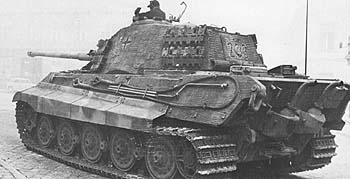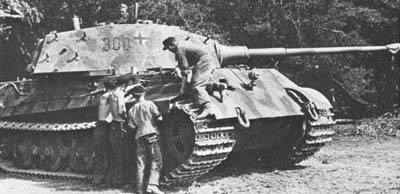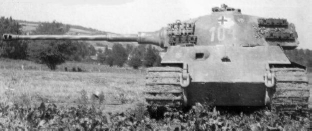|
|
|
King Tiger

German "Konigstiger"
PzKpfw VI Ausf. B - Tiger II
This German battle tank was also known as "Tiger B" and "Royal Tiger" and was the last major German tank design to see service during the war. It went into production late in 1943 and first saw action on the Russian Front in May 1944. It was born of a demand from the Army Weapons Office in August 1942 for a redesigned Tiger tank incorporating thick armour, sloped plates to deflect shots, and an 88mm gun. Both Porsche and Henschel, Henschel being the original producer of the Tiger I, were asked to submit designs: both their first designs were rejected. Porsche then submitted a fresh one but was turned down because it used an electric transmission which demanded excessive amounts of copper, and Henschel\rquote s second try, known as the VK4503 (H), was accepted.
Delays were occasioned when the Army Weapons Office demanded some changes in the design to make production easier, and the first prototype was not delivered for test until October 1943. The pilot model left the production line in December 1943, and first production models began to reach the army late in February 1944 - a commendable speed in view of the difficulties facing manufacturers in Germany by that time. Production was hoped to reach 145 tanks a month by the end of 1944, but bombing of facilities and shortages of raw materials prevented this, and the best figure ever reached was 85 tanks in August 1944. By the end of the war some 484 King Tigers had been produced.
Power was provided by a 24litre V-12 Maybach HL230 petrol engine, the same as fitted in the Panther tank, producing 700bhp and able to drive the 70ton tank 24mph on solid terrain. In effect, the King Tiger was a logical improvement of the Tiger, incorporating various features which experience had shown were desirable; notably the front glacis plate, which was now sloped as on the Panther and Soviet T-34 tanks instead of squarely vertical as on the original Tiger. The armour protection was the heaviest yet seen: the front plate was 150mm set at a 40-degree angle, the turret face was 180mm thick, and side and tail plates 80mm thick. Frontal attack of this tank, by any weapon available to the Allies, was out of the question. The main gun was an 88mm of 71 calibers in length, firing a 23lb shell at 3,280ft/sec and capable of piercing 6.25in (160mm) of armour at 2,000yd range, a truly formidable performance.
Crew: 5
Weight: 68.0 ton
Dimensions: 10.3 x 3.76 x 3.08
Armor: 40 - 180 mm
Range: 170 km
Speed (max): 35 km/hr
Main gun: 88 mm L/71
No. Produced: 489



